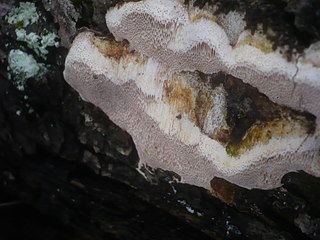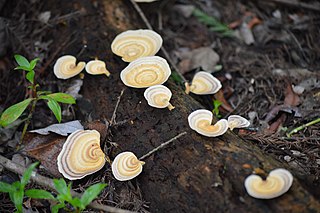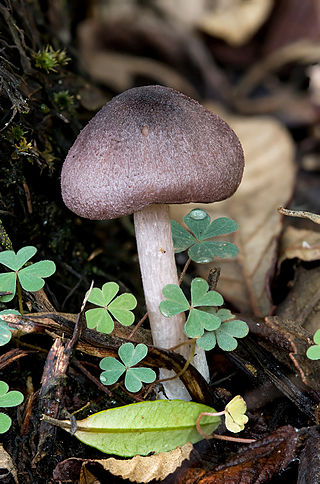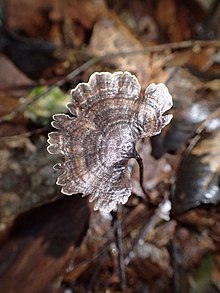Abundisporus is a small genus of poroid fungi currently with seven recognized species. They differ from other polypores in having coloured rather than hyaline spores.

Perenniporia is a cosmopolitan genus of bracket-forming or crust-like polypores in the family Polyporaceae. They are dimitic or trimitic with smooth, thick-walled basidiospores and cause a white rot in affected wood.

Buglossoporus is a genus of fungi in the family Fomitopsidaceae. The genus was circumscribed in 1966 by Czech mycologists František Kotlába and Zdeněk Pouzar, with Buglossoporus quercinus as the type species. In some works, Buglossoporus has been treated as a synonym of Piptoporus.

Antrodiella is a genus of fungi in the family Steccherinaceae of the order Polyporales.

Amauroderma is a genus of polypore fungi in the family Ganodermataceae. The genus, widespread in tropical areas, contains about 70 species. Amauroderma fungi are wood-decay fungi that feed and fruit on decayed branches and trunks.

Microporellus is a genus of poroid fungi in the family Polyporaceae.
Navisporus is a genus of seven species of tropical poroid fungi in the family Polyporaceae. It was circumscribed by Norwegian mycologist Leif Ryvarden in 1980 with Navisporus floccosus as the type species. This fungus, first described as Trametes floccosa by Giacomo Bresadola in 1896, is thought to have been originally collected in Tanzania.

Pachykytospora is a small genus of poroid fungi in the family Polyporaceae. Species in the cosmopolitan genus cause white rot. There are about 10 species in the genus, with newest member described from European Russia in 2007. Pachykytospora species have fruit bodies that are resupinate, with light brown tubes. They are characterized by their uneven, ellipsoid spores, and the Polyporus-like skeletal-binding hyphae.

Tyromyces is a genus of poroid fungi in the family Polyporaceae. It was circumscribed by mycologist Petter Karsten in 1881. The type species is the widely distributed Tyromyces chioneus, commonly known as the white cheese polypore. The phylogenetic position of Tyromyces within the Polyporales is uncertain, but it appears that it does not belong to the "core polyporoid clade". Tyromyces is polyphyletic as it is currently circumscribed, and has been described as "a dumping place for monomitic white-rot species with thin-walled spores."

Entoloma austroprunicolor is a species of agaric fungus in the family Entolomataceae. Described as new to science in 2007, it is found in Tasmania, where it fruits on the ground of wet sclerophyll forests in late spring to early winter. The fruit bodies (mushrooms) have reddish-purple caps measuring up to 5 cm (2.0 in) in diameter supported by whitish stipes measuring 3–7.5 cm (1.2–3.0 in) long by 0.2–0.6 cm (0.1–0.2 in) thick. On the cap underside, the crowded gills are initially white before turning pink as the spores mature.

Picipes badius, commonly known as the black-footed polypore or black-leg, is a species of fungus in the family Polyporaceae. It causes a white rot of hardwoods and conifers. The species is found in temperate areas of Asia, Australia, Europe, and North America. It has a dark brown or reddish-brown cap that reaches a diameter of 25 cm (9.8 in), and a stipe that is often completely black or brown at the top and black at the base.

Boletus subluridellus is a species of bolete fungus in the family Boletaceae. Described as new to science in 1971 by American mycologists, the bolete is found in the eastern United States and Canada. It grows on the ground in coniferous and mixed forests in a mycorrhizal association with deciduous trees, especially oak. The fruit bodies (mushrooms) have orangish-red, broadly convex caps that are up to 10 cm (3.9 in) in diameter, with small, dark reddish pores on the underside. The pale yellow stipe measures 4–9 cm (1.6–3.5 in) long by 1.5–2.3 cm (0.6–0.9 in) thick. All parts of the fruit body will quickly stain blue when injured or touched.

Loweomyces fractipes is a species of poroid fungus in the family Steccherinaceae, and the type species of the genus Loweomyces. It is a widely distributed species, found in North America, Europe, Central America, South America, and Korea.
Nigrohydnum is a fungal genus in the order Polyporales. It contain a single species, Nigrohydnum nigrum, a rare toothed polypore known from only a few collections in Brazil.
Truncospora is a genus of 10 species of fungi in the family Polyporaceae.
Yuchengia is a fungal genus in the family Polyporaceae. It is a monotypic genus, containing the single species Yuchengia narymica, a crust fungus formerly placed in the genus Perenniporia and originally described as Trametes narymica by Czech mycologist Albert Pilát.
Mycorrhaphium citrinum is a species of tooth fungus in the family Steccherinaceae that is found in Africa. It was described as a new species in 1989 by Norwegian mycologist Leif Ryvarden. The type collection was made in Chati, a region in the Copperbelt Province in Zambia, where it was found growing in leaf litter.
Lignosus dimiticus is a species of poroid fungus in the family Polyporaceae that is found in Zaire. Its fruit body features a funnel-shaped cap that is up to 10 cm (3.9 in) in diameter and 15 mm (0.6 in) in the centre. The smooth, white stipe has a woody texture, and measures 8 cm (3.1 in) long and 12–20 mm (0.5–0.8 in) thick. Unlike other members of Lignosus, L. dimiticus has a dimitic hyphal system, as it lacks binding hyphae in its trama and context.
Vanderbylia vicina is a species of poroid fungus in the family Polyporaceae, and the type species of the genus Vanderbylia.
Microporellus papuensis is a species of poroid fungus in the family Polyporaceae that was described as new in 2007. It was found growing from the ground in Madang, Papua New Guinea, and is only known to occur in the type locality.











